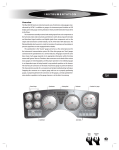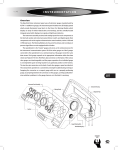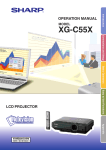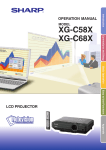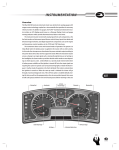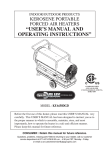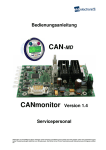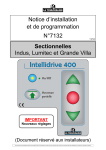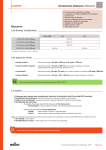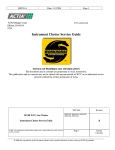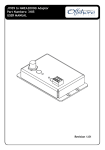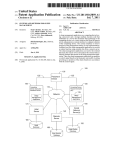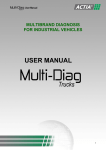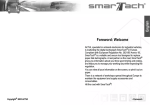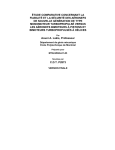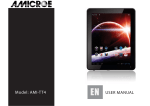Download Actia Gauges in - New York Bus Sales
Transcript
Tech Tip From your friends at New York Bus Sales Product Affected- Actia Gauges in2004-2008 Vision 2004-present All American “A3 Models” Complaint - We keep getting a message through the LCD display that reads “GAUGE MISSING”……(Figure #1) Note that pressing the “exit” button will remove the message from the LCD screen. ELECTRICAL TECH TIP #11-0406 – Actia Dash Page 1 52765 Bridger Court Elkhart, IN 46514 USA Phone: 574 264 2373 www.actia.com BBA3 Instrument Panel Service Manual NOTICE OF PROPRIETARY INFORMATION This document and its contents are proprietary to Actia. This publication and its contents may not be reproduced or distributed for any purposes without the written permission of Actia. Classification No Confidential. ACTIA Confidential. client Written By Date Russell Parks 11/16/04 Reviewed Approved Kevin Decker ACTIA Ref. Revision Service Manual FF03023 D © 2011 Any reproduction of this document whether total or partial without the written consent of ACTIA is forbidden. Page 1 Format US Letter BBA3 Instrument 07/19/2005 FF03023 rev D Page 2 of 45 Date: 04/05/11 REVISION TRACKING SHEET Rev A B C D Modified R. Parks R. Parks R. Parks R. Parks Date 11-16-04 06-28-05 07-07-05 07-19-05 Comment Original Release Updated to current software functionality Updated for changes in the functionality of the speed detect output Updated for changes in the functionality of the alternator and engine door messages. FF03023 rev D 04/05/11 Page 3/45 ______________________________________________________________________________________ Table of Content 1. PART NUMBERS AND FEATURES ..................................................................................................................................6 1.1. DASH PANEL: .........................................................................................................................................................................6 1.2. SERVICE PARTS: ....................................................................................................................................................................6 2. ELEMENTS ...........................................................................................................................................................................7 3. INPUTS AND OUTPUTS .....................................................................................................................................................8 3.1.1. Connectors: ...................................................................................................................................................................8 3.1.2. J1 - Speedometer power/communication connector .....................................................................................................8 3.1.3. J2 - Speedometer I/O connector (inputs & outputs)......................................................................................................9 3.1.4. J3 - Speedometer Slave connector (communication, power supply) .............................................................................9 3.1.5. Warning Module Binary Input connector ...................................................................................................................10 3.1.6. Switch Harness Connections .......................................................................................................................................10 OPERATION ...........................................................................................................................................................................11 3.2. DISPLAY ODOMETER & CLOCK ............................................................................................................................................11 3.3. TURN SIGNAL/HAZARD WARNING LIGHTS ............................................................................................................................ 11 3.4. START-UP MODE .................................................................................................................................................................11 3.4.1. Gauges ........................................................................................................................................................................11 3.4.2. LCD.............................................................................................................................................................................11 3.4.3. Warning Lights ........................................................................................................................................................... 11 3.4.4. Communication ........................................................................................................................................................... 11 3.4.5. Audible Alarm ............................................................................................................................................................. 11 3.5. TURN-OFF ............................................................................................................................................................................12 3.6. SELF-DIAGNOSTIC MODE .....................................................................................................................................................12 4. IGNITION MODE ............................................................................................................................................................... 12 4.1. GAUGE DISPLAY ..................................................................................................................................................................12 4.1.1. Master Gauge – Speedometer .....................................................................................................................................12 4.1.2. Tachometer / Clock .....................................................................................................................................................12 4.1.3. Coolant temperature ...................................................................................................................................................12 4.1.4. Oil Pressure ................................................................................................................................................................ 12 4.1.4.1. Cummins ......................................................................................................................................................... 12 4.1.4.2. John Deere & CAT ......................................................................................................................................... 12 4.1.5. Fuel gauge ..................................................................................................................................................................13 4.1.5.1. Cummins & CAT ............................................................................................................................................. 13 4.1.5.2. John Deere ..................................................................................................................................................... 13 4.1.6. Voltmeter .....................................................................................................................................................................13 4.1.6.1. Cummins & CAT ............................................................................................................................................. 13 4.1.6.2. John Deere ..................................................................................................................................................... 13 4.1.7. Ammeter ......................................................................................................................................................................13 4.1.8. Front Air Gauge.......................................................................................................................................................... 13 4.1.9. Rear Air Gauge ........................................................................................................................................................... 13 4.1.10. Transmission temperature.........................................................................................................................................13 4.2. APPLIED AIR FEATURE .........................................................................................................................................................13 4.2.1. Applied Front Air Gauge ............................................................................................................................................14 4.2.2. Applied rear Air Gauge ..............................................................................................................................................14 4.3. BACKLIGHTING ....................................................................................................................................................................14 4.4. GAUGES INTERNAL WARNING INDICATORS .........................................................................................................................14 4.4.1. Low Oil Pressure ........................................................................................................................................................14 4.4.2. High Coolant Temperature .........................................................................................................................................14 ______________________________________________________________________________________________________ © 2011 Any reproduction of this document whether total or partial without the written consent of ACTIA is forbidden FF03023 rev D 04/05/11 Page 4/45 ______________________________________________________________________________________ 4.4.3. High Transmission Temperature ................................................................................................................................ 14 4.4.4. Low Fuel Level............................................................................................................................................................ 14 4.4.5. Low Air Pressure - Front ............................................................................................................................................14 4.4.6. Low Air Pressure - rear ..............................................................................................................................................15 4.4.7. Low/High Battery voltage ...........................................................................................................................................15 4.4.8. Low Applied Air Pressure - Front............................................................................................................................... 15 4.4.9. Low Applied Air Pressure - rear .................................................................................................................................15 4.5. WARNING BANK INDICATORS ..............................................................................................................................................15 4.5.1. Left Turn .....................................................................................................................................................................15 4.5.2. Right Turn ...................................................................................................................................................................15 4.5.3. Park Brake ..................................................................................................................................................................15 4.5.4. High Beam ..................................................................................................................................................................15 4.5.5. Stop Engine .................................................................................................................................................................15 4.5.6. Wait to Start ................................................................................................................................................................ 15 4.5.6.1. CAT ......................................................................................................................................................... 15 4.5.6.2. Cummins ......................................................................................................................................................... 16 4.5.7. Check Transmission ....................................................................................................................................................16 4.5.8. Range Inhibit .............................................................................................................................................................. 16 4.5.9. ABS .............................................................................................................................................................................16 4.5.10. High Hydraulic oil temperature ................................................................................................................................ 16 4.5.11. Retarder ....................................................................................................................................................................16 4.5.12. Stop Light ..................................................................................................................................................................16 4.5.13. Hydraulic brake failure.............................................................................................................................................16 4.5.14. Low coolant level ......................................................................................................................................................16 4.5.15. High Transmission Temperature .............................................................................................................................. 16 4.5.16. Sanders Refill ............................................................................................................................................................ 16 4.5.17. Engine Warning ........................................................................................................................................................17 4.5.18. Maintenance Indicator Lamp ....................................................................................................................................17 4.6. AUDIBLE ALARM .................................................................................................................................................................17 4.7. BINARY OUTPUTS ................................................................................................................................................................ 18 4.7.1. Speed Detect ............................................................................................................................................................... 18 4.7.2. Lift Authorization ........................................................................................................................................................19 5. COMMUNICATION .......................................................................................................................................................... 20 5.1. PLUG AND PLAY FUNCTION .................................................................................................................................................20 5.2. COMMUNICATION ERRORS...................................................................................................................................................20 5.3. MESSAGES SENT ..................................................................................................................................................................20 5.3.1. Service Brake .............................................................................................................................................................. 20 5.3.2. Throttle Interlock ........................................................................................................................................................20 5.3.3. Brake Interlock ........................................................................................................................................................... 21 5.4. J1939 TABLE OF MESSAGES ................................................................................................................................................22 6. MESSAGE DISPLAY CENTER ........................................................................................................................................23 6.1. DRIVE MODE SCREEN .......................................................................................................................................................... 23 6.2. ODOMETER ..........................................................................................................................................................................23 6.2.1. Accuracy .....................................................................................................................................................................24 6.2.2. Normal Shutdown .......................................................................................................................................................24 6.2.3. Abnormal shutdown ....................................................................................................................................................24 6.2.4. Durability ....................................................................................................................................................................25 6.2.5. Error Recovery ........................................................................................................................................................... 25 6.2.6. Maximum Reading ......................................................................................................................................................25 6.2.7. Service Programming .................................................................................................................................................25 6.2.8. Service Gauges ........................................................................................................................................................... 25 6.3. TRIP ODOMETER ..................................................................................................................................................................25 6.4. PRIORITY MESSAGES ........................................................................................................................................................... 26 ______________________________________________________________________________________________________ © 2011 Any reproduction of this document whether total or partial without the written consent of ACTIA is forbidden FF03023 rev D 04/05/11 Page 5/45 ______________________________________________________________________________________ 6.4.1. Eng Comm Failure ......................................................................................................................................................26 6.4.2. Trans Comm Failure ...................................................................................................................................................26 6.4.3. Alternator ....................................................................................................................................................................26 6.4.4. Lift Not Stowed............................................................................................................................................................ 26 6.4.5. Battery Voltage Error .................................................................................................................................................26 6.4.6. Vehicle speed Error ....................................................................................................................................................26 6.4.7. Turn signal ON ........................................................................................................................................................... 26 6.4.8. Water in Fuel .............................................................................................................................................................. 26 6.4.9. Headlight Alert ........................................................................................................................................................... 27 6.4.10. Engine Door Open ....................................................................................................................................................27 6.5. SECOND LINE DISPLAY SELECTION ......................................................................................................................................27 6.5.1. Cummins & CAT .........................................................................................................................................................27 6.5.2. John Deere ..................................................................................................................................................................28 6.6. SETTINGS AND DIAGNOSTIC .................................................................................................................................................29 6.6.1. Set Units ......................................................................................................................................................................29 6.6.2. Contrast ......................................................................................................................................................................29 6.6.3. Read Parameters.........................................................................................................................................................30 6.6.3.1. Cummins & CAT ............................................................................................................................................. 30 6.6.3.2. John Deere ..................................................................................................................................................... 31 6.6.4. Instrument Diagnostics ...............................................................................................................................................31 6.6.4.1. Gauge Test ...................................................................................................................................................... 32 6.6.4.2. Lamp Test ....................................................................................................................................................... 32 6.6.4.3. LCD Test......................................................................................................................................................... 32 6.6.4.4. Binary Inputs .................................................................................................................................................. 33 6.6.4.5. Analog Inputs (Cummins) ............................................................................................................................... 33 6.6.4.6. Analog Inputs (CAT)....................................................................................................................................... 34 6.6.4.7. Analog Inputs (John Deere) ........................................................................................................................... 34 6.6.4.8. Data Link ........................................................................................................................................................ 35 6.6.4.9. Engine Diagnostic .......................................................................................................................................... 35 6.6.4.10. Trans Diagnostic .......................................................................................................................................... 35 6.7. SETUP MENU .......................................................................................................................................................................36 6.7.1. Trip .............................................................................................................................................................................36 6.7.2. Default Parameter ......................................................................................................................................................36 6.7.3. Self Test .......................................................................................................................................................................36 6.7.4. Transmission Diagnostics ...........................................................................................................................................37 6.7.5. Test Panel ...................................................................................................................................................................37 6.7.6. Manual Transmission..................................................................................................................................................37 6.7.7. Turn Signal Click ........................................................................................................................................................38 6.7.8. Stop Light Inhibit ........................................................................................................................................................38 6.7.9. Diesel Engine .............................................................................................................................................................. 38 6.7.10. Diesel Engine Type ...................................................................................................................................................39 6.7.11. Sanders Refill Warning light .....................................................................................................................................39 6.7.12. Brake Interlock .........................................................................................................................................................39 6.7.13. Lift Authorization ......................................................................................................................................................39 6.7.14. Engine Door Open ....................................................................................................................................................40 7. GLOSSARY/ABBREVIATIONS .......................................................................................................................................40 8. TROUBLESHOOTING ......................................................................................................................................................41 ______________________________________________________________________________________________________ © 2011 Any reproduction of this document whether total or partial without the written consent of ACTIA is forbidden FF03023 rev D 04/05/11 Page 6/45 ______________________________________________________________________________________ 1. PART NUMBERS AND FEATURES 1.1. Dash Panel: Assembly # 0077816 Panel # 104474 BB Service Panel # 0079104 0086105 0085244 0085244 Description Instrument Panel Assembly - BBA3 Instrument Panel Assembly - BBA3 - AC 1.2. Service Parts: Actia # BBB # Description 104496 0079091 Master Gauge Speedo – 90 MPH 104497 0079092 Master Gauge Speedo – 140 KMH 102081 0057500 Tach / Clock Slave Gauge 102060 0057505 102072 0057503 102084 0057504 102063 0057501 102066 0057506 102078 0057507 102087 0057509 102075 0057511 105819 0079106 104500 0079105 Voltmeter Slave Gauge Oil Pressure Slave Gauge Coolant Temp Slave Gauge Fuel Level Slave Gauge Front Air Pressure Slave Gauge Rear Air Pressure Slave Gauge Trans Temp Slave Gauge Ammeter Slave Gauge Warning Bank Module w/ Air 18 position telltale LED PWA 18 position telltale overlay 106516 ______________________________________________________________________________________________________ © 2011 Any reproduction of this document whether total or partial without the written consent of ACTIA is forbidden FF03023 rev D 04/05/11 Page 7/45 ______________________________________________________________________________________ 42 220 100 260 220 TRANS TEMP 300 75 50 FRONT 100 AIR 125 °F 0 260 30 20 25 0 30 110 30 16 F 50 70 30 ENG OIL 90 130 0 0 AMP 24 23 30 90 150 90 AMP 150 150 R 150 AMP 51 150 5 T 7 6 1 2 3 4 5 6 7 8 9 10 11 12 13 14 15 16 17 18 19 20 21 22 23 24 25 26 RPM X 100 10 M 2 400 25 10 10 0 90 8 km/h 140 E 20 80 0 MPH 10 120 50 10 12 14 60 15 60 80 340 70 REAR 100 AIR PSI 25 125 50 40 150 VOLTS 75 50 26 FUEL °F 180 F 49 27 28 29 30 PSI 25 5 180 ENG TEMP 140 0 48 32 31 41 43 44 40 45 46 20 47 36 35 34 33 40 39 38 37 2. ELEMENTS 3 4 Headlight Switch Panel Dimmer Hi Idle Switch Low Idle Switch m (Mode) Button Message Display Center t (toggle) Button Range Inhibit Warning Light Sanders Warning Light Wait to Start Warning Light MIL Warning Light Engine Warning Light H (Hour) Button Clock M (Minute) Button Tire Chains Switch Adjust Pedals Switch Cruise On/Off Switch Cruise Set/Resume Switch Exhaust Brake Switch Low Oil Pressure Warning Light Ammeter Warning Light Ammeter Gauge Oil Pressure Gauge Low Fuel Warning Light Fuel Gauge M H 12 8 9 10 27 28 29 30 31 32 33 34 35 36 37 38 39 40 41 42 43 44 45 46 47 48 49 50 51 11 22 15 13 14 16 21 17 18 19 20 High Trans Temp WL (In Gauge) Transmission Temp Gauge Tachometer Gauge Stop Light Warning Light Low Coolant Level Warning Light Right Turn Signal Engine Retarder Warning Light Stop Engine Warning Light Hi Hydraulic Temp Warning Light Hi Beam Warning Light Check Trans Warning Light Hydraulic Brake Failure High Trans Temp Warning Light ABS Warning Light Park Brake Warning Light Left Turn Signal Speedometer Front Air Gauge Front Air Warning Light Voltmeter gauge Coolant Temperature Gauge High Coolant Temp Warning Rear Air Gauge Rear Air Warning Light High / Low Voltage Warning Light ______________________________________________________________________________________________________ © 2011 Any reproduction of this document whether total or partial without the written consent of ACTIA is forbidden FF03023 rev D 04/05/11 Page 8/45 ______________________________________________________________________________________ 3. INPUTS AND OUTPUTS 3.1.1. CONNECTORS: Mating connectors for the gauges and warning modules are TYCO GET .64 sealed connectors. The speedometer has three connectors associated with it: J1 – an eight (8) position for power/communication, J2 – a 16 position for input and output connections, and J3 for slave device power and communications The figures below show the connector pin numbering from the wire entry side with the latch on top. This numbering can also be found on the connector housing. The Mating Terminals (Sockets) used with the connector housings are Tyco P/N: 1393366-1 (Actia P/N 100952) 3.1.2. J1 - SPEEDOMETER POWER/COMMUNICATION CONNECTOR 8 positions (2 X 4) (Actia P/N 100950) Tyco US Part Number: 1411001-1 Terminal Designation 1 2 3 4 5 6 7 8 Battery Ground CAN+ CANJ1708+ J1708Not used CAN Res Bluebird Harness Pin Out Unswitched positive (+) 14V P26-R Chassis ground P26-C SAE J1939 Databus P29-11 SAE J1939 Databus P29-12 SAE J1708/J1587 Databus N/A SAE J1708/J1587 Databus N/A N/A CAN Termination Resistor N/A Description Wire Mrkg 1185 1206S J1939 + J1939 N/A N/A N/A N/A ______________________________________________________________________________________________________ © 2011 Any reproduction of this document whether total or partial without the written consent of ACTIA is forbidden FF03023 rev D 04/05/11 Page 9/45 ______________________________________________________________________________________ 3.1.3. J2 - SPEEDOMETER I/O CONNECTOR (INPUTS & OUTPUTS) 16 Positions (Actia P/N 100951) Tyco US Part Number: 1438031-1 Terminal Designation Description Bluebird Pin Out Wire Mrkg 1 Fuel level sender See Chart P26-J 1403B 2 Wait to Start Active low – Wait to Start P27-11 1436 Hyd. Brake Sys. P27-8 2431B 3 Failure Active low – Hydraulic Brake set 4 Dimmer PWM voltage input from dimmer –Wake up input P26-A 1333A 5 Oil pressure sender See Chart P26-N 1417 6 Headlight Alert Internal Harness connection to Parking lights N/A N/A 7 Ammeter + Ammeter (Hall Effect Output) P26-E 1440A 8 Engine Door Open Active low – Engine Door Open P26-G Engine Door P26-S VEH SPEED 9 Speed detect out Vehicle speed 3 mph = output low 10 Lift Authorization See Flow Chart P26-L LIFT AUTH 11 Ignition Switched high for ignition on –Wake up input P26-H 11136G 12 Left Turn Switched high (ign) parallel with turn signal –Wake up input P29-4 1313A 13 Right Turn Switched high (ign) parallel with turn signal – Wake up input P29-5 1323A 14 Park brake switch Switched high = Park Brake set and icon on P29-2 1521E 15 Stop Light Switched high = Service Brake engaged and icon on P27-7 1316D 16 Hi Beam Switched high = Headlight Hi Beam engaged and icon on P27-10 1334A Signal low = Chassis Ground (0.0V – 1.5V) Signal high = 4.0V up to Ignition Voltage 3.1.4. J3 - SPEEDOMETER SLAVE CONNECTOR (COMMUNICATION, POWER SUPPLY) 4 Positions (Actia P/N 100949) Tyco US Part Number: 9-1419167-0 Terminal 1 2 3 4 Designation +7.6V Power Ground LIN Open Description Slave device power output Slave device ground LIN Databus Bluebird Harness Pin Out N/A N/A N/A N/A ______________________________________________________________________________________________________ © 2011 Any reproduction of this document whether total or partial without the written consent of ACTIA is forbidden FF03023 rev D 04/05/11 Page 10/45 ______________________________________________________________________________________ 3.1.5. WARNING MODULE BINARY INPUT CONNECTOR 8 positions (2 X 4) (Actia P/N 100950) Tyco US Part Number: 1411001-1 Terminal Designation Description 1 Hi Hyd. Oil Temp Active low – Hi Hyd. Oil Temp 2 Alternator Active low – Alternator Failure 3 Sanders Refill Active low – Sanders Box Empty 4 ABS Active low – ABS System Warning 5 Water In Fuel Active low – Water in Fuel 6 Lift Not Stowed Active low – Lift Not Stowed 7 Retarder Active low – Engine Retarder Engaged 8 Door Open Active low – Door Open Signal low = Chassis Ground (0.0V – 1.5V) Signal high = 4.0V up to Ignition Voltage Bluebird Harness Pin Out P27-1 P27-3 P27-6 P29-3 P27-9 P27-2 P27-4 P26-D Wire Mrkg 2220 1460 1445 1710 WIF LNS SIG Retard Lgt 1262C 3.1.6. SWITCH HARNESS CONNECTIONS Description Head Lights In Head Lights Out Park Lights In Park Lights Out High Idle In High Idle Out Switch Input (GND) Low Idle Inc. Output Low Idle Dec. Output Cruise Set Output Cruise Res Output Cruise On/Off Output Switch lights (GND) Bluebird Harness Wire Mrkg Pin Out P28-E 1160 P28-F 1301 P28-G 1167 P28-H / P28-J 1315A / 1335 P28-B 1521C P28-A 15106 P28-N 1206X P28-C 1442 P28-D 1443 P28-M 1529 P28-L 1528 P28-K 1504 P26-B 1212D Eaton Pin# 2B 3 5B 4/6 2B 3 2B 3 1 3 1 3 7&8 Note: Sanders, Pedal Adjust and Transmission Retarder switches are wired with an optional harness at Bluebird. ______________________________________________________________________________________________________ © 2011 Any reproduction of this document whether total or partial without the written consent of ACTIA is forbidden FF03023 rev D 04/05/11 Page 11/45 ______________________________________________________________________________________ OPERATION 3.2. Display Odometer & Clock The odometer & clock value will be displayed with the ignition off when the vehicle lights are turned on as long as the panel dimmer level is greater than approximately 10%. 3.3. Turn signal/Hazard warning lights The right and left turn icons are operational with the ignition off when their respective binary input becomes high. Hazard lights normally turn both the right and left turn binary inputs high. 3.4. Start-Up Mode The Master enters start-up mode when the ignition is turned on. The ignition binary input is used to sense if the key switch is on or off. The start up self-test is an option enabled through the setup menu. The factory setting for this option is enabled. 3.4.1. GAUGES Gauge pointers will drive to zero position. The pointers will then drive up scale, pausing at ½ scale, before completing the sweep to full scale. The pointers will then return to zero position before moving to the commanded position. 3.4.2. LCD During the up scale sweep of the pointers, the LCD will turn all its segments on for one second, off for one second and then display the opening message. The opening message is the Bluebird logo followed by the software ID, complete with revision level. 3.4.3. WARNING LIGHTS Starting at the up scale pointer sweep, all warning lights will turn on for 5 seconds and then go out. Active warning lights will turn on when the gauges go to their commanded position. 3.4.4. COMMUNICATION The speedometer will determine which data buses are connected and which devices are present. Error messages will display if a data bus is missing or a device that had been previously found is now missing. 3.4.5. AUDIBLE ALARM The audible alarm will sound its three different tones for one second each during the up scale swing of the pointers. ______________________________________________________________________________________________________ © 2011 Any reproduction of this document whether total or partial without the written consent of ACTIA is forbidden FF03023 rev D 04/05/11 Page 12/45 ______________________________________________________________________________________ 3.5. Turn-off When the ignition line goes low all gauges will zero, except the fuel gauge, and the odometer value will be stored to the EEPROM before the IP turns itself off. This will take up to 4 seconds. While off, the instrument panel will consume less than 1mA from the hot battery power input. 3.6. Self-Diagnostic Mode The self-diagnostic mode is entered through a menu selection using the LCD. Diagnostics is only available when the Park Brake is set. Detail specifications are found in the Message Display Center section. The self-diagnostic includes the following tests: Gauges Warning Lights LCD Binary Inputs Analog Inputs Data Links 4. IGNITION MODE 4.1. Gauge Display 4.1.1. MASTER GAUGE – SPEEDOMETER The speedometer is a standard gauge for the Instrument Panel and is the master gauge in the system. The speedometer data source will be J1939 (PGN65265) 4.1.2. TACHOMETER / CLOCK The tachometer gauge is a standard slave gauge used to display engine RPM. The tachometer data source will be J1939 (PGN61444). 4.1.3. COOLANT TEMPERATURE The coolant temperature gauge is a standard slave gauge used to display engine coolant temperature. The coolant temperature data source will be J1939 (PGN65262). 4.1.4. OIL PRESSURE 4.1.4.1. Cummins The oil pressure gauge is a standard slave gauge used to display engine oil pressure. The oil pressure is driven by the oil pressure sender analog input. 4.1.4.2. John Deere & CAT The oil pressure gauge is a standard slave gauge used to display engine oil pressure. The oil pressure data source will be J1939 (PGN65263). ______________________________________________________________________________________________________ © 2011 Any reproduction of this document whether total or partial without the written consent of ACTIA is forbidden FF03023 rev D 04/05/11 Page 13/45 ______________________________________________________________________________________ 4.1.5. FUEL GAUGE 4.1.5.1. Cummins & CAT The fuel gauge is a standard slave gauge used to display fuel tank level. The Fuel Level is driven by the fuel level sender analog input. Fuel level will be sampled over a one-minute period to prevent fuel slosh. 4.1.5.2. John Deere The fuel gauge is a standard slave gauge used to display fuel tank level. The fuel level data source will be J1939 (PGN65276.) The data range is between 5% (empty) and 95% (full). 4.1.6. VOLTMETER 4.1.6.1. Cummins & CAT The voltmeter gauge is a standard slave gauge used to display chassis voltage. The voltmeter data source will be J1939 (PGN65271). 4.1.6.2. John Deere The voltmeter gauge is a standard slave gauge used to display chassis voltage. The voltmeter data source will be J1939 (PGN65271JD). 4.1.7. AMMETER The ammeter gauge is an optional slave gauge used to display battery charging / discharging conditions. The ammeter is driven by Hall effect sender into an analog input. 4.1.8. FRONT AIR GAUGE The front air gauge is an optional gauge used when air pressure is required. The gauge displays Front Air Pressure. The warning bank transducer drives the Front Air Pressure Gauge. 4.1.9. REAR AIR GAUGE The rear air gauge is an optional gauge used when air pressure is required. The gauge displays Rear Air Pressure. The warning bank transducer drives the Rear Air Pressure Gauge. 4.1.10. TRANSMISSION TEMPERATURE The transmission temperature gauge is a optional slave gauge used to display transmission oil temperature. The transmission temperature data source will be J1939 (PGN65272). 4.2. Applied Air Feature The applied air feature is used to monitor front and rear brake line pressure. This feature is activated when the master gauge detects the presence of one or all of the applied air kit. ______________________________________________________________________________________________________ © 2011 Any reproduction of this document whether total or partial without the written consent of ACTIA is forbidden FF03023 rev D 04/05/11 Page 14/45 ______________________________________________________________________________________ 4.2.1. APPLIED FRONT AIR GAUGE The applied front air gauge is an optional gauge used when applied air pressure is required. The gauge displays Applied Front Air Pressure. The warning bank transducer # 2 drives the Applied Front Air Pressure Gauge. 4.2.2. APPLIED REAR AIR GAUGE The applied rear air gauge is an optional gauge used when applied air pressure is required. The gauge displays Applied Rear Air Pressure. The warning bank transducer # 2 drives the Applied Rear Air Pressure Gauge. 4.3. Backlighting The PWM dimmer for panel illumination feeds into the master gauge so that the gauge components can match the dimming of other panel components. The master gauge interprets this input as indicated in the table below: Dimmer Input 0%-9% 10-100% Ignition V LCD Backlight Maximum brightness Linearly go from min to max brightness Gauge Backlight Off Linearly go from min to max brightness 4.4. Gauges Internal Warning Indicators 4.4.1. LOW OIL PRESSURE The data source of the Low Oil Pressure warning light indicator is J1939 (DM1SPN100). 4.4.2. HIGH COOLANT TEMPERATURE The data source of the High Coolant Temperature indicator is J1939 (DM1SPN110). 4.4.3. HIGH TRANSMISSION TEMPERATURE The data source of the High Transmission Temperature indicator is J1939 (PGN65272) with a threshold of 250F calculated by the master gauge. The alternate data source of the high transmission temperature is J1939 (DM1HighTransTempLamp). The logic is programmed to alarm on either conditions. 4.4.4. LOW FUEL LEVEL Low Fuel Level icon turns on when the fuel level is less than 12.5% and turns off when the level is above 18%. 4.4.5. LOW AIR PRESSURE - FRONT Low Air Pressure - Front indicator turns on when the front air pressure is less than or equal to 65 PSI. The indicator will turn off at 72 PSI. ______________________________________________________________________________________________________ © 2011 Any reproduction of this document whether total or partial without the written consent of ACTIA is forbidden FF03023 rev D 04/05/11 Page 15/45 ______________________________________________________________________________________ 4.4.6. LOW AIR PRESSURE - REAR Low Air Pressure - Rear indicator turns on when the rear air pressure is less than or equal to 65 PSI. The indicator will turn off at 72 PSI. 4.4.7. LOW/HIGH BATTERY VOLTAGE Low/High battery voltage icon turns on when the battery voltage is less than 12v or is more than 15.4v. 4.4.8. LOW APPLIED AIR PRESSURE - FRONT Low Air Pressure – Due to system operation parameters, this warning light does not turn on. 4.4.9. LOW APPLIED AIR PRESSURE - REAR Low Air Pressure – Due to system operation parameters, this warning light does not turn on. 4.5. Warning Bank Indicators 4.5.1. LEFT TURN Left Turn indicator turns on when the left turn binary input is switched high. If the left turn indicator is left on for a measured distance of 1 mile, then the alert tone will be activated and the message center will display “Left Turn”. 4.5.2. RIGHT TURN Right Turn indicator turns on when the right turn binary input is switched high. If the right turn indicator is left on for a measured distance of 1 mile, then the alert tone will be activated and the message center will display “Right Turn”. 4.5.3. PARK BRAKE Park Brake indicator is turned on when the park brake is set (park brake input is high). 4.5.4. HIGH BEAM High Beam indicator is turned on when the high beam binary input is switched high. 4.5.5. STOP ENGINE Stop Engine indicator is J1939 driven (DM1RedStopLamp). 4.5.6. WAIT TO START 4.5.6.1. CAT Wait to Start indicator is turned on when the wait to start binary input is switched low (analog input used as binary input). ______________________________________________________________________________________________________ © 2011 Any reproduction of this document whether total or partial without the written consent of ACTIA is forbidden FF03023 rev D 04/05/11 Page 16/45 ______________________________________________________________________________________ 4.5.6.2. Cummins Wait to Start indicator is J1939 driven (PGN65252). 4.5.7. CHECK TRANSMISSION Check Transmission indicator is J1939 driven (Allison DM1 CheckTransLamp). 4.5.8. RANGE INHIBIT The Range Inhibit indicator is J1939 driven by the Transmission (PGN65098). 4.5.9. ABS The ABS indicator is turned on when the ABS binary input is switched low. 4.5.10. HIGH HYDRAULIC OIL TEMPERATURE High hydraulic oil temperature indicator is turned on when the high hydraulic oil temperature binary input is switched low. 4.5.11. RETARDER Retarder indicator is turned on when the retarder binary input is switched low. 4.5.12. STOP LIGHT Stop Light indicator is turned on when the stop light binary input is switched high. 4.5.13. HYDRAULIC BRAKE FAILURE Hydraulic brake failure indicator is turned on when the hydraulic brake failure input is switched low (analog input used as binary input). 4.5.14. LOW COOLANT LEVEL The data source of the Coolant level is J1939 (DM1LowCoolantLamp). 4.5.15. HIGH TRANSMISSION TEMPERATURE The data source of the High Transmission Temperature indicator is J1939 (PGN65272) with a threshold of 250F calculated by the master gauge. The alternate data source of the high transmission temperature is J1939 (DM1HighTransTempLamp). The logic is programmed to alarm on either conditions. 4.5.16. SANDERS REFILL Sanders refill indicator is turned on when the sanders refill binary input is switched low. This warning lights operation will be selectable through a configuration bit and can be set through the set up menu. ______________________________________________________________________________________________________ © 2011 Any reproduction of this document whether total or partial without the written consent of ACTIA is forbidden FF03023 rev D 04/05/11 Page 17/45 ______________________________________________________________________________________ 4.5.17. ENGINE WARNING The data source of the engine warning is J1939 (DM1CheckEngLamp). 4.5.18. MAINTENANCE INDICATOR LAMP The data source of the maintenance indicator is J1939 (DM1EngMaintLamp). 4.6. Audible Alarm The audible alarm is used in the following conditions: Audible Alarm Continuous 1 Continuous 1 Continuous 1 Continuous 1 Continuous 1 Continuous 1 Continuous 1 Continuous 1 Continuous 1 Continuous 1 Continuous 1 Continuous 1 Continuous 1 Beep 1 Beep 1 Designation High Hydraulic Temperature Stop engine Low coolant level Low Oil Pressure High Coolant Temperature High Transmission Temp Hydraulic Brake Failure Engine Warning Low/High chassis voltage Front low air pressure Criteria Binary input PGN 65226 DM1 Red Stop Lamp PGN 65,226 SPN 111 FMI 1 & 18 PGN 65,226 SPN 100 FMI 1 or 18 PGN 65,226 SPN 110 FMI 0 or 16 PGN 65272 SPN 177 FMI 15 Or hi Trans temp Analog input PGN 65226 DM1 Check Engine Lamp PGN 65271 When ≤ 11.9V or ≥ 15.4V Analog input - When ≤ 62 PSI (448 kPa) Priority 1 1 1 1 1 1 1 2 2 2 Rear low air pressure Alternator Engine Door Open ABS Wait to start 2 2 2 2 2 Beep 1 Beep 1 Beep 1 Range inhibit Sanders refill Low Fuel Level Analog input - When ≤ 62 PSI (448 kPa) Binary input & Engine Speed ≥ 400 RPM Binary input Binary input PGN 65252 Byte 4 – Bits 2-1 / Binary input (CAT) PGN 65098 Byte 2 – Bits8-7 Binary input When < 13% Beep 1 Turn signal reminder (1) 8 Beep 1 Beep 2 Water in Fuel Headlight Alert reminder Binary input (3) 4 (6) Beep 3 Turn signals 5 5 4 (4) (1) Turn signal reminder is ON if the right or the left turn signal indicator is left ON for a distance of 1 mile. (2) The click for the turn signals are always generated but might not be heard (for example if the buzzer is also ON) (3) Headlight Alert reminder is ON - If the headlights / parking lights are on when ignition is turned OFF (during 2 minutes or until headlights / parking lights are turned off) (4) Headlight Alert reminder has a lower priority than a buzzer (continuous 1) but a higher priority than an alert (Beep 1). The audible tone are defined in the table below: Audible Alarm Continuous 1 Beep 1 Beep 2 Beep 3 Freq 1 2900 2000 2900 2000 T1 160ms 160ms 160ms 40ms Freq 2 0 0 0 T2 160ms 160ms 160ms Freq 3 T3 Period Continuous 320ms 320ms Once Priority ______________________________________________________________________________________________________ © 2011 Any reproduction of this document whether total or partial without the written consent of ACTIA is forbidden FF03023 rev D 04/05/11 Page 18/45 ______________________________________________________________________________________ Example: Period T1 Freq1 T2 Freq2 T3 Freq3 4.7. Binary Outputs 4.7.1. SPEED DETECT This binary output is active (low side drive) when vehicle speed 3 MPH is detected. ______________________________________________________________________________________________________ © 2011 Any reproduction of this document whether total or partial without the written consent of ACTIA is forbidden FF03023 rev D 04/05/11 Page 19/45 ______________________________________________________________________________________ 4.7.2. LIFT AUTHORIZATION This binary output is active when the requirements are met, shown in the flow chart below: START Lift Authorize Output is unavailable (No Power) NO Ignition On? YES Lift Authorize Output is inactive (high) NO Park Brake Set? YES NO Lift Not Stowed? Lift Authorize Output is active (low) YES Once lift authorize is activated the lift not stowed signal will “latch on” lift authorize until removed, regardless of the changes in park brake or neutral. Transmit Throttle Interlock (See 5.3.2) Transmit Service Brake = Off (See 5.3.1) In Neutral? YES NO Door Open YES ______________________________________________________________________________________________________ © 2011 Any reproduction of this document whether total or partial without the written consent of ACTIA is forbidden FF03023 rev D 04/05/11 Page 20/45 ______________________________________________________________________________________ 5. COMMUNICATION There are two communication channels for data transfer between the vehicle and the speedometer. One channel for SAE J1708/J1587 and a second channel for CAN 2.0B/SAE J1939 (Controller Area Network). All frames transmitted by the speedometer on J1939 are continuously sent at the standard broadcast rate for the frame using source address (SA) 23dec (17h). The speedometer communicates via the LIN bus to slave devices. The slave gauges are updated every 400mSec except for the tachometer which is updated every 80mSec. 5.1. Plug and Play Function The master keeps a “roll call” list and verifies that all devices are present during start up. The master listens for devices on each communication bus and remembers which devices are present during initialization. When a new device is found it is added to the roll call list. If a device is found missing, a message will be sent to the LCD but the roll call list is not updated. Devices can only be removed from the list through the diagnostic menu 5.2. Communication Errors If a parameter is not received by J1939 for 5 seconds it will be flagged as missing. Missing LCD information will display a “-“ and missing gauge information will be signaled by wagging the pointer from dial end to dial end. A missing J1939 data bus will be announced in the LCD. If a LIN parameter is missing for 5 seconds the gauge will wag the pointer from dial end to dial end and flash the warning LED. 5.3. Messages Sent 5.3.1. SERVICE BRAKE The service brake message is sent to the engine via J1939 (PGN65265SB ) when the brake pedal is depressed. 5.3.2. THROTTLE INTERLOCK The throttle interlock message is sent to the engine via J1939 (CAT - PGN65264) or (Cummins PGN61441) when the proper lift safety conditions are met (see 4.7.2) or when the proper brake interlock conditions are met (see 5.3.3). ______________________________________________________________________________________________________ © 2011 Any reproduction of this document whether total or partial without the written consent of ACTIA is forbidden FF03023 rev D 04/05/11 Page 21/45 ______________________________________________________________________________________ 5.3.3. BRAKE INTERLOCK The function of the brake interlock (when activated) is shown in the flow chart below: START NO Ignition On? YES NO End Speed Detect Output Active YES Door Open Binary Active YES Transmit Throttle Interlock (See 5.3.2) ______________________________________________________________________________________________________ © 2011 Any reproduction of this document whether total or partial without the written consent of ACTIA is forbidden FF03023 rev D 04/05/11 Page 22/45 ______________________________________________________________________________________ 5.4. J1939 Table of Messages Applies to: Cummins ISC03, CAT C7, John Deere CNG, Allison 2000 and Allison WT (MD380) Frame PGN Name Byte TX/RX Engine Hours Cruise Control/Vehicle Speed Cruise Control/Vehicle Speed PTO EBC1 Shutdown DM1 DM1 DM1 EEC1 EEC2 Engine Fluid Level/Pressure Engine Temperature ETC1 ETC7 Fuel Economy Fuel Economy Inlet/Exhaust Conditions Inlet/Exhaust Conditions Transmission Fluids Vehicle Electrical Power Vehicle Electrical Power 65,253 (00FEE5) 65,265 (00FEF1) 65,265 (00FEF1) 65,264 (00FEF0) 61,441 (00F001) 65,252 (00FEE4) 65,226 (00FECA) 65,226 (00FECA) 65,226 (00FECA) 61,444 (00F004) 61,443 (00F003) 65,263 (00FEEF) 65,262 (00FEEE) 61,442 (00F002) 65,098 (00FE4A) 65,266 (00FEF2) 65,266 (00FEF2) 65,270 (00FEF6) 65,270 (00FEF6) 65,272 (00FEF8) 65,271 (00FEF7) 65,271 (00FEF7) Dash Display Defined Faults English Units H MPH Metric Units H km/H RPM % PSI F RPM % KPa C MPG MPG PSI F F V V L/100Km L/100Km KPa C C V V % Source Address 0 1,2,3,4 2,3 4 b 6&5 6 b 2&1 4 b 2&1 4 b 2&1 3-6 1 b 4&3 1 b 6&5 4,5 3 4 1 N/A 2 b 8&7 3,4 5,6 2 3 5,6 5,6 7,8 RQ RX TX TX TX RX RX RX RX RX RX RX RX RX RX RX RX RX RX RX RX RX 65276 (00FEFC) PGN Total engine hours Wheel-based vehicle speed Service Brake Throttle Interlock Throttle Interlock Wait to Start Active DTC Amber warning lamp Red Stop lamp Engine speed Percent load Engine oil pressure Engine coolant temp. Electronic Trans. Controller Shift inhibit Instantaneous fuel econ Average fuel economy Boost pressure Intake manifold temperature Transmission oil temp. Electrical potential (volts) Battery potential (volts) Switched Fuel Level Name 2 Byte RX SPN % FMI DM1 65,226 (00FECA) High Coolant Temp 3-6 110 DM1 65,226 (00FECA) Low Oil Pressure 3-6 100 DM1 65,226 (00FECA) 65,226 (00FECA) 177 15 3 DM1 65,226 (00FECA) Low Coolant Level 1 b 4&3 3-6 1 b 4&3 3-6 3-6 2003 DM1 Amber warning light/Check Transmission High Trans Temperature 0, 11 and 16 1, 11 and 18 31 111 1, 11 and 18 0 0 3 Note: In the table bytes are numbered 1 to n and bits are numbered 1 to 8. 1 is LSb. ______________________________________________________________________________________________________ © 2011 Any reproduction of this document whether total or partial without the written consent of ACTIA is forbidden FF03023 rev D 04/05/11 Page 23/45 ______________________________________________________________________________________ 6. MESSAGE DISPLAY CENTER The message display is a graphical, backlit, LCD that displays information to the vehicle operator. The messages that are displayed include: 1. Odometer 2. Trip Odometer (optional) 3. Boost Pressure (Cummins / CAT) 4. Percent Engine Load 5. Instantaneous Fuel Rate (Cummins / CAT) 6. Average Fuel Rate (Cummins / CAT) 7. Engine hours 8. Engine RPM 9. Coolant Temperature 10. Engine Oil Pressure 11. Fuel Level 12. Transmission Temperature 13. Primary Air Pressure 14. Secondary Air Pressure 15. Dimmer % 16. Intake Manifold Temperature 17. Vehicle Speed 18. Battery Voltage 19. Ammeter 20. Instrument Panel Diagnostic Information 6.1. Drive Mode Screen During normal operation the LCD displays the odometer or trip value on the top line and a selected parameter on the second line. (Boost Pressure shown in the following example) 1234.5 mi 0 PSI Boost 6.2. Odometer The odometer function is in the speedometer. The season odometer displays 0.0 - 9,999,999.9 and the trip odometer, when offered, will display 0.0 - 9999.9. Both have a resolution of 0.1 mi/km. Leading zeros are only displayed in the 1’s position. The vehicle distance is calculated every 80 msec. from the vehicle speed transmitted on the J1939 data bus by the engine ECM and stored within the speedometer in kilometers. It can be displayed on the LCD in miles or kilometers. The odometer reading will be displayed when the ignition switch is off by activating the gauge backlight. ______________________________________________________________________________________________________ © 2011 Any reproduction of this document whether total or partial without the written consent of ACTIA is forbidden FF03023 rev D 04/05/11 Page 24/45 ______________________________________________________________________________________ 6.2.1. ACCURACY Accuracy of the odometer value is dependant on two (2) main variables. 1) The algorithm in the speedometer for calculating distance, and 2) the speed value transmitted by the ECM. The algorithm has been designed and written to calculate the distance with the accuracy and resolution necessary to exceed SAE recommendations. The distance is calculated every 80 msec. to reduce error during any rapid speed change the vehicle might make. The speed data is dependant on the calibration parameters for tire size and axle ratio being properly entered into the ECM. These are the same parameters necessary to have the ECM properly calculate the vehicle speed and distance value. Testing has indicated that the algorithm will calculate mileage within 0.07% of actual based on the speed received. This far exceeds the SAE recommended 0.3% found in SAE J1226. 6.2.2. NORMAL SHUTDOWN The odometer value is stored to the EEPROM at each 1-kilometer increment (0.62 mi) and when the ignition switch is turned off. The value is stored to 1/100 of a kilometer resolution (33 ft) using a 4-byte memory location within an array. Each store is made sequentially to one (1) of eight (8) locations in the array so at any point in time the last eight (8) values are maintained. Each value stored is verified at the time it is saved. Multiple store attempts to a location will be made if necessary, and if not successful, the memory location will be tagged as bad. The "precount" that is used to increment the odometer every 1/100th km is also saved. The "precount value is 115200. Therefore, our internal resolution is 1/11520000th of a km or 0.003385827 inches. This value is stored on power down and recovered on power up. Value n Byte 1 Byte 2 Odometer Value Array Byte Byte Value Byte 1 3 4 n+4 Value n+1 Byte 1 Byte 2 Byte 3 Byte 4 Value n+5 Byte 1 Byte 2 Byte 3 Byte 4 Value n+2 Byte 1 Byte 2 Byte 3 Byte 4 Value n+6 Byte 1 Byte 2 Byte 3 Byte 4 Value n+3 Byte 1 Byte 2 Byte 3 Byte 4 Value n+7 Byte 1 Byte 2 Byte 3 Byte 4 Byte 2 Byte 3 Byte 4 6.2.3. ABNORMAL SHUTDOWN If there is battery power loss at the speedometer prior to turning the ignition off, an abnormal shut down will occur. The odometer value, when power is restored, will return to the last kilometer increment value saved; i.e. the last XXX.0 kilometer rollover. Therefore, the maximum distance lost by an abnormal shutdown will be 0.9 km (0.56 mi). Battery loss that occurs >4 seconds after turning the ignition off will NOT result in an abnormal shutdown. The occurrence of an abnormal shutdown during the life of a vehicle should be rare. ______________________________________________________________________________________________________ © 2011 Any reproduction of this document whether total or partial without the written consent of ACTIA is forbidden FF03023 rev D 04/05/11 Page 25/45 ______________________________________________________________________________________ 6.2.4. DURABILITY The EEPROM store routine will allow for a minimum of 4 million store cycles. The design will accommodate 200 key-offs per day, 260 days per year, for 20 years plus 1.609344 million kilometers (1,000,000 mi) which could be seen if the vehicle is used on a delivery route, with a 50% safety factor (200*260*20+1,609,334) = 2,649,334+51% = 4,000,494 store cycles. An error recovery scheme is implemented that will allow the odometer value to be recovered should a hardware failure in one of the EEPROM memory cells occur. 6.2.5. ERROR RECOVERY The error recovery algorithm will check each stored value to determine if the values are in sequence (low to high) and 1 km or less apart. If this condition is found no errors are present and no further action is required. If a value is found to be out of order or greater than 1 km from the others, the software will identify the largest value in the group with the proper sequence and use that value. In the unlikely event the speedometer fails in such a way that the odometer value cannot be displayed, the factory, in most instances, will be able to recover the stored value. 6.2.6. MAXIMUM READING The odometer will stop incrementing when the maximum display count is reached. Therefore, the value will not rollover to zero and continue incrementing but will freeze at 9,999,999.9. 6.2.7. SERVICE PROGRAMMING If replacement of the speedometer becomes necessary, the actual vehicle mileage may be programmed into the odometer using Actia proprietary software. The mileage may be incremented, but not decremented, using this software. 6.2.8. SERVICE GAUGES Replacement speedometers will be shipped in a mode that allows the installer to preset actual vehicle distance, thus eliminating the need to “tag” the vehicle. Documentation on how this mode works can be found in Actia document # 104426. 6.3. Trip Odometer The trip odometer may be displayed by pressing the t button. This will toggle you between the Odometer and the Trip Odometer. You will know the trip odometer is being displayed by the T1 symbol in the top right corner of the message center display. To reset trip odometer press and hold the “M” button until it clears. 1234.5 mi 0 PSI T1 Boost ______________________________________________________________________________________________________ © 2011 Any reproduction of this document whether total or partial without the written consent of ACTIA is forbidden FF03023 rev D 04/05/11 Page 26/45 ______________________________________________________________________________________ 6.4. Priority Messages Priority messages are displayed in the LCD due to various inputs or data messages. When a new fault appears, associated priority message is displayed, overwriting the odometer/trip display. After 5s, the exit command will appear, allowing the return to the normal display by pressing the m button. If several faults are defined, the more command will be displayed. It will then be possible to scroll thru the list of faults by pressing the t button. 6.4.1. ENG COMM FAILURE This message is displayed when the master gauge does not receive the J1939 data from the engine. This is accomplished by monitoring for the presence of the engine speed message (PGN61444). 6.4.2. TRANS COMM FAILURE This message is displayed when the master gauge does not receive the J1939 data from the transmission. This is accomplished by monitoring for the presence of the ETC #1 message (PGN61442). 6.4.3. ALTERNATOR This message is displayed when the associated binary input is switched low and engine speed is 400 RPM (PGN61444). 6.4.4. LIFT NOT STOWED This message is displayed when the associated binary input is switched low. 6.4.5. BATTERY VOLTAGE ERROR This message is displayed if the voltage message received from the ECM via the J1939 contains a wrong value (error or not available or underrange or overrange) (PGN65271). 6.4.6. VEHICLE SPEED ERROR This message is displayed if the vehicle speed received from the ECM via the J1939 contains a wrong value (error or not available) during a certain time (PGN65265). 6.4.7. TURN SIGNAL ON This message is displayed if the right or the left turn signal indicator is left ON for a distance of 1 mile 6.4.8. WATER IN FUEL This message is displayed when the associated binary input is switched low. ______________________________________________________________________________________________________ © 2011 Any reproduction of this document whether total or partial without the written consent of ACTIA is forbidden FF03023 rev D 04/05/11 Page 27/45 ______________________________________________________________________________________ 6.4.9. HEADLIGHT ALERT The headlight alert message is displayed on the message center when the headlights / parking lights are on (input is high) and ignition is turned off. The headlight alert message will flash on & off at a 1 sec interval for a period of 2 minutes, or until the headlights / parking lights is turned off. 6.4.10. ENGINE DOOR OPEN “Engine Door” should be displayed when the associated binary input is switched low. 6.5. Second Line Display Selection 6.5.1. CUMMINS & CAT Pressing the m button for < 5 seconds allows the selection of the parameter to be displayed on the second line. The parameter will highlight in reverse video indicating it is selected. Pressing the m or t button will display a different parameter from the list. To select the highlighted parameter simply do nothing and the highlight will disappear leaving the parameter displayed. Parameters that can be displayed are: Intake Manifold Temperature 1234.5 mi 180 F IMT 1234.5 mi Engine Load 70 % Eng L 1234.5 mi Hourmeter Boost Pressure Instantaneous Fuel Economy 67.8 hr 1234.5 mi 70 PSI Boost 1234.5 mi 20.3 mpg Inst F ______________________________________________________________________________________________________ © 2011 Any reproduction of this document whether total or partial without the written consent of ACTIA is forbidden FF03023 rev D 04/05/11 Page 28/45 ______________________________________________________________________________________ Average Fuel Economy 1234.5 mi 20.3 mpg Avg F 6.5.2. JOHN DEERE Pressing the m button for < 5 seconds allows the selection of the parameter to be displayed on the second line. The parameter will highlight in reverse video indicating it is selected. Pressing the m or t button will display a different parameter from the list. To select the highlighted parameter simply do nothing and the highlight will disappear leaving the parameter displayed. Parameters that can be displayed are: Intake Manifold Temperature 1234.5 mi 180 F Engine Load Hourmeter IMT 1234.5 mi 70 % Eng L 1234.5 mi 67.8 hr ______________________________________________________________________________________________________ © 2011 Any reproduction of this document whether total or partial without the written consent of ACTIA is forbidden FF03023 rev D 04/05/11 Page 29/45 ______________________________________________________________________________________ 6.6. Settings and Diagnostic With the park brake set and in the Drive Mode Screen, pressing the m button for >5 seconds brings up the following screen: 1-Set Units 2-Contrast 3-Instrument Diag \/ Select /\ The item highlighted in reverse video will be selected when both the m and t buttons are pressed together. Pressing the m or t button separately will move the highlight through the list, as indicated by the arrow, so other items can be selected. There are 6 items in this menu as follows: 4- Read Param 5-Ammeter Calib 6-Engine Diag \/ Select /\ 6.6.1. SET UNITS Selecting menu item 1 brings up the following screen that is used to select if values are to be displayed in metric units or English units. Current Units ENGLISH Press t for METRIC Press m to Exit 6.6.2. CONTRAST Selecting menu item 2 display a screen to allow setting the LCD contrast. Pressing the m (+) button will increase contrast while pressing the t (-) button will decrease contrast. CONTRAST ADJUST + - ______________________________________________________________________________________________________ © 2011 Any reproduction of this document whether total or partial without the written consent of ACTIA is forbidden FF03023 rev D 04/05/11 Page 30/45 ______________________________________________________________________________________ 6.6.3. READ PARAMETERS 6.6.3.1. Cummins & CAT Item 4-Read Param – This screen displays various parameter received by the master gauge. The main use for these screens is in troubleshooting the system. Eng RPM 775 RPM Coolant T 160F Oil Press 54 PSI \/ EXIT /\ Fuel Level 100% Trans Temp 160F Dimmer % 0% \/ EXIT /\ Boost Pr Engine Load Inst Fuel \/ EXIT 5 PSI 25% 0 mpg /\ Avg Fuel Man Temp Hrs \/ EXIT 5 mpg 100F 67.80 /\ V InjSpeed Press Battery V Speed Ammeter Battery \/ 0 mph 120 PSI 13V 0 mph 50 A13V /\ EXIT Air Rear Ammeter 50124 A PSI Air Front 124 PSI Rear 124 PSI Air Front 124 PSI \/ EXIT /\ ______________________________________________________________________________________________________ © 2011 Any reproduction of this document whether total or partial without the written consent of ACTIA is forbidden FF03023 rev D 04/05/11 Page 31/45 ______________________________________________________________________________________ 6.6.3.2. John Deere Item 4-Read Param – This screen displays various parameter received by the master gauge. The main use for these screens is in troubleshooting the system. Eng RPM 775 RPM Coolant T 160F Oil Press 54 PSI \/ EXIT /\ Fuel Level 100% Trans Temp 160F Dimmer % 0% \/ EXIT /\ Engine Load Man Temp Hrs \/ EXIT V Speed Battery Ammeter \/ EXIT Air Rear Air Front \/ 25% 100F 67.80 /\ 0 mph 13V 50 A /\ 124 PSI 124 PSI EXIT /\ 6.6.4. INSTRUMENT DIAGNOSTICS Selecting menu item 3 in the Settings and Diagnostic Menu will display the instrument diagnostic menu. There are 6 items in this menu and is navigated the same as the previous menu. 1-Gauge Test 2-Lamp Test 3-LCD Test \/ Select /\ 4-Binary Inputs 5-Analog Inputs 6-Data Links \/ Select /\ ______________________________________________________________________________________________________ © 2011 Any reproduction of this document whether total or partial without the written consent of ACTIA is forbidden FF03023 rev D 04/05/11 Page 32/45 ______________________________________________________________________________________ 6.6.4.1. Gauge Test The selected gauge will be driven through three positions pausing at each position for 500 mSec. as shown in the LCD as a percentage of scale. This test will proceed through all gauges and return to the menu. Pressing the m button (Exit) will end the test and return to the menu. Fuel Level EXIT 0% Fuel Level EXIT 50% Fuel Level EXIT 100% 6.6.4.2. Lamp Test Item 2-Lamp Test – Turns each IP warning lamp (not the vehicle load) on then off displaying the lamp name and status in the LCD. This test goes through all warning lamps and then returns to the menu. Pressing the m button (Exit) will end the test and return to the menu. (High beam test shown as an example) High Beam EXIT ON High Beam EXIT OFF 6.6.4.3. LCD Test Item 3 – Displays the Bluebird logo in normal and reverse video three times and then returns to the menu. ______________________________________________________________________________________________________ © 2011 Any reproduction of this document whether total or partial without the written consent of ACTIA is forbidden FF03023 rev D 04/05/11 Page 33/45 ______________________________________________________________________________________ 6.6.4.4. Binary Inputs Item 4 – Displays the module, pin number, and status of each binary input defined in the system. Pressing the m button exits the test and returns to the menu. Pressing the t button scrolls the display to the next 4 inputs. The value “high” and “low” refers to the voltage level at the connector pin. This information will be continuously updated to assist in troubleshooting. Press t to Scroll Press m to Exit S-1 S-2 S-3 S-4 Hydr Temp Alternator Sanders R ABS Low Low Low Low S-5 S-6 S-7 S-8 Water in Fuel LNS Retarder Door Open Low Low Low Low M-11 M-12 M-13 M-14 Ign ON High Left turn High Right turn High Park Brake High M-15 Stop Light M-16 High Beam High High 6.6.4.5. Analog Inputs (Cummins) Item 5 – Displays the module, pin number, and status “Out of Range High”, “Out of Range Low”, or the actual value of each analog input defined in the system. Pressing the m button exits the test and returns to the menu. Pressing the t button scrolls the display to the next 4 inputs. Press t to Scroll Press m to Exit M-1 M-3 M-4 M-5 Fuel Hydr F Dimmer Oil Press M-6 Headlights M-7 Amp M-8 Eng. Door 100% Off 0% 100% 0V 12A On ______________________________________________________________________________________________________ © 2011 Any reproduction of this document whether total or partial without the written consent of ACTIA is forbidden FF03023 rev D 04/05/11 Page 34/45 ______________________________________________________________________________________ 6.6.4.6. Analog Inputs (CAT) Item 5 – Displays the module, pin number, and status “Out of Range High”, “Out of Range Low”, or the actual value of each analog input defined in the system. Pressing the m button exits the test and returns to the menu. Pressing the t button scrolls the display to the next 4 inputs. Press t to Scroll Press m to Exit M-1 M-2 M-3 M-4 Fuel Wait Hydr F Dimmer M-6 Headlights M-7 Amp M-8 Eng. Door 100% Off Off 0% 0V 12A On 6.6.4.7. Analog Inputs (John Deere) Item 5 – Displays the module, pin number, and status “Out of Range High”, “Out of Range Low”, or the actual value of each analog input defined in the system. Pressing the m button exits the test and returns to the menu. Pressing the t button scrolls the display to the next 4 inputs. Press t to Scroll Press m to Exit M-3 M-4 M-6 M-7 M-8 Hydr F Dimmer Headlights Amp Eng. Door Off 0% 0V 12A On ______________________________________________________________________________________________________ © 2011 Any reproduction of this document whether total or partial without the written consent of ACTIA is forbidden FF03023 rev D 04/05/11 Page 35/45 ______________________________________________________________________________________ 6.6.4.8. Data Link Item 6– The LIN will be checked and each device found on that data bus would be displayed. The roll call for the LIN bus may be updated using the appropriate menu selection. Devices may only be deleted if they are designated inactive. 1-<LIN> \/ Select /\ Fuel Level Active Battery Volt Active Ammeter Active \/ Delete /\ Oil Pressure Active Coolant Temp Active Trans Temp Active \/ Delete /\ Engine Speed Front Air Rear Air \/ Delete Active Active Active /\ Warning Bank Active \/ Delete /\ 6.6.4.9. Engine Diagnostic Item 6-Engine Diagnostics – This screen displays the Suspect Parameter Number (SPN) and Failure mode Identifier (FMI) as received from the engine for active faults via J1939 (DM1SPN100) (Two active faults shown below as an example) SPN 100 FMI 1 SPN 110 FMI 0 End of list \/ Exit /\ 6.6.4.10. Trans Diagnostic Item 7-Trans Diagnostics – This screen displays the Suspect Parameter Number (SPN) and Failure mode Identifier (FMI) as received from the transmission for active faults via J1939 (DM1HighTransTempLamp). (Two active faults shown below as an example) SPN 2003 FMI 31 SPN 177 FMI 15 End of list \/ Exit /\ ______________________________________________________________________________________________________ © 2011 Any reproduction of this document whether total or partial without the written consent of ACTIA is forbidden FF03023 rev D 04/05/11 Page 36/45 ______________________________________________________________________________________ 6.7. Setup Menu Holding m and t pressed while turning the ignition on enters the setup menu. Trip, Default Parameter, Self-Test and can be enabled and disabled by the user. 6.7.1. TRIP Shows if the Trip Odometer is present (YES). Pressing m (OK) will go to the next selection. Pressing both m and t will exit to the start up screen. Trip Odometer YES OK Exit NO TOGGLE Pressing t (TOGGLE) will toggle between YES and NO, while pressing m (OK) will save the selection and go to the next selection. Pressing both m and t will exit to the start up screen. 6.7.2. DEFAULT PARAMETER Shows if the default parameter line is present (YES). Pressing m (OK) will go to the next selection. Pressing both m and t will exit to the start up screen. Default Parameter YES NO OK Exit TOGGLE Pressing t (TOGGLE) will toggle between YES and NO, while pressing m (OK) will save the selection and go to the next selection. Pressing both m and t will exit to the start up screen. 6.7.3. SELF TEST When YES is selected, the start up self test will zero the pointers, sound three tones from the speaker, sweep the gauge pointers through 50%, 100%, then back to zero, and turn all warning lights on for 5 seconds. When NO is selected the pointers will zero and all warning lights will be turned on for 5 seconds SELF TEST YES OK Exit NO TOGGLE Pressing t (TOGGLE) will toggle between YES and NO, while pressing m (OK) will save the selection and go to the next selection. Pressing both m and t will exit to the start up screen. ______________________________________________________________________________________________________ © 2011 Any reproduction of this document whether total or partial without the written consent of ACTIA is forbidden FF03023 rev D 04/05/11 Page 37/45 ______________________________________________________________________________________ 6.7.4. TRANSMISSION DIAGNOSTICS When YES is selected, the active transmission SPN and FMI faults are displayed. When NO is selected the transmission diagnostics functions are deactivated. TRANSMISSION DIAG YES NO OK Exit Pressing t (TOGGLE) will toggle between YES and NO, while pressing m (OK) will save the selection and go to the next selection. Pressing both m and t will exit to the start up screen. The toggle function is not active on this menu and will be activated upon future implementation. 6.7.5. TEST PANEL When YES is selected, the software is configured as a production chassis test fixture. When NO is selected the production chassis test fixture are deactivated. This feature can only be activated through Actia provided software. TEST PANEL YES OK NO Exit Pressing m (OK) will save the selection and go to the next selection. Pressing both m and t will exit to the start up screen. The toggle function is not active on this menu 6.7.6. MANUAL TRANSMISSION When YES is selected, the configure the software to ignore the loss of transmission communications and not display a “TRANS COMM” message as listed in paragraph 7.4.3. When NO is selected the manual transmission functions are deactivated. MANUAL TRANSMISSION YES NO OK Exit Pressing t (TOGGLE) will toggle between YES and NO, while pressing m (OK) will save the selection and go to the next selection. Pressing both m and t will exit to the start up screen. The toggle function is not active on this menu and will be activated upon future implementation. ______________________________________________________________________________________________________ © 2011 Any reproduction of this document whether total or partial without the written consent of ACTIA is forbidden FF03023 rev D 04/05/11 Page 38/45 ______________________________________________________________________________________ 6.7.7. TURN SIGNAL CLICK When YES is selected, the software is configured to enable the turn signal “click”. When NO is selected the turn signal “click”, the turn signal “ON” (see 6.4.7) and the turn signal “reminder audible alarm” (see 4.6 (1)) will be disabled. TURN SIGNAL CLICK YES NO OK Exit TOGGLE Pressing t (TOGGLE) will toggle between YES and NO, while pressing m (OK) will save the selection and go to the next selection. Pressing both m and t will exit to the start up screen. 6.7.8. STOP LIGHT INHIBIT When YES is selected, the software is configured to disable the “stop light” warning indicator, unless in a warning condition created from the brake interlock circuit (see 4.5.12). When NO is selected the “stop light” warning indicator will be enabled (see 4.5.12). STOP LIGHT INHIBIT YES NO OK Exit TOGGLE Pressing t (TOGGLE) will toggle between YES and NO, while pressing m (OK) will save the selection and go to the next selection. Pressing both m and t will exit to the start up screen. 6.7.9. DIESEL ENGINE When YES is selected, the software is configured to select the Cummins/CAT option for the second line display (see 6.5.1). When NO is selected, the software will select the John Deere option for the second line display (see 6.5.2). DIESEL ENGINE YES NO OK Exit TOGGLE Pressing t (TOGGLE) will toggle between YES and NO, while pressing m (OK) will save the selection and go to the next selection. Pressing both m and t will exit to the start up screen. ______________________________________________________________________________________________________ © 2011 Any reproduction of this document whether total or partial without the written consent of ACTIA is forbidden FF03023 rev D 04/05/11 Page 39/45 ______________________________________________________________________________________ 6.7.10. DIESEL ENGINE TYPE When Cummins is selected, the software is configured to select the Cummins Engine package option. When CAT is selected, the software will select the CAT Engine option. DIESEL ENGINE TYPE Cummins CAT OK Exit TOGGLE Pressing t (TOGGLE) will toggle between YES and NO, while pressing m (OK) will save the selection and go to the next selection. Pressing both m and t will exit to the start up screen. 6.7.11. SANDERS REFILL WARNING LIGHT When YES is selected, the software is configured to disable the “Sanders” warning indicator (see 5.5.16). When NO is selected the “Sanders” warning indicator will be enabled (see 4.5.16). SANDERS LIGHT INHIBIT YES NO OK Exit TOGGLE Pressing t (TOGGLE) will toggle between YES and NO, while pressing m (OK) will save the selection and go to the next selection. Pressing both m and t will exit to the start up screen. 6.7.12. BRAKE INTERLOCK When YES is selected, the software is configured to enable the brake interlock function (see 5.3.3). When NO is selected the brake interlock function will be disabled (see 5.3.3). BRAKE INTERLOCK YES NO OK Exit TOGGLE Pressing t (TOGGLE) will toggle between YES and NO, while pressing m (OK) will save the selection and go to the next selection. Pressing both m and t will exit to the start up screen. 6.7.13. LIFT AUTHORIZATION When YES is selected, the software is configured to enable the lift authorization function (see 5.7.2). When NO is selected the lift authorization function will be disabled (see 4.7.2). LIFT AUTHORIZE YES NO OK Exit TOGGLE Pressing t (TOGGLE) will toggle between YES and NO, while pressing m (OK) will save the selection and go to the next selection. Pressing both m and t will exit to the start up screen. ______________________________________________________________________________________________________ © 2011 Any reproduction of this document whether total or partial without the written consent of ACTIA is forbidden FF03023 rev D 04/05/11 Page 40/45 ______________________________________________________________________________________ 6.7.14. ENGINE DOOR OPEN When YES is selected, the software is configured to enable the engine door open function (see 6.4.10). When NO is selected the lift authorization function will be disabled (see 6.4.10). ENGINE DOOR OPEN YES NO OK Exit TOGGLE Pressing t (TOGGLE) will toggle between YES and NO, while pressing m (OK) will save the selection and go to the next selection. Pressing both m and t will exit to the start up screen. 7. GLOSSARY/ABBREVIATIONS TBD – To be determined EEPROM – Electrically Erasable Programmable Read Only Memory SAE – Society of Automotive Engineers PGN – Parameter Group Number (J1939) SPN – Suspect Parameter Number (J1939) FMI – Failure Mode Identifier (J1939) ECM – Electronic Control Module TVD – Total Vehicle Distance ______________________________________________________________________________________________________ © 2011 Any reproduction of this document whether total or partial without the written consent of ACTIA is forbidden FF03023 rev D 04/05/11 Page 41/45 ______________________________________________________________________________________ 8. TROUBLESHOOTING Observation (Symptom) All gauge pointers wagging end to end; LCD message “Eng Comm Failure” or “Trans Comm Failure”; Various warning lights may be on or off but are not flashing Problem No J1939 Databus being received by the speedometer 2 All gauge pointers, except speedometer, wagging end to end; All warning lights are flashing No LIN Databus between the speedometer and the other gauges and warning modules 3 Instrument panel does not power up; No activity on any gauge or warning lights Speedometer indicating 0; Read parameter Speed = 0 Engine controller sending speed data as zero (0) on J1939 1 4 5 6 7 8 9 10 11 12 13 14 Speedometer pointer wagging; Read parameter Speed = NA Tachometer pointer wagging; Read parameter Eng RPM = NA Tachometer pointer wagging; Read parameter Eng RPM = a value No engine speed data on J1939 Coolant temp gauge pointer wagging; Coolant temp warning light OFF or ON; Read parameter coolant temp = NA Coolant temp gauge pointer wagging; Coolant temp warning light flashing No coolant temp data on J1939 Oil pressure gauge pointer wagging; Oil pressure warning light OFF or ON; Read parameter oil psi = NA Oil pressure gauge pointer wagging; Oil pressure warning light flashing No oil pressure data on J1939 Oil pressure gauge pointer stuck at maximum Oil pressure gauge pointer stuck at maximum Oil pressure gauge pointer stuck at minimum Wrong engine selected No engine speed data on J1939 No LIN Databus going to tachometer No LIN Databus going to coolant temp gauge No LIN Databus going to oil pressure gauge Oil pressure sender open circuit Oil pressure sender shorted Things to check 1) Wiring at speedometer 8 position connector pins 3, 4, & 8 2) IP J1939 stub disconnected from backbone harness 3) Bus termination resistor missing (speedometer 8 position connector pins 4 & 8 must be connected together 4) Engine or Transmission controllers not configured for J1939 communication 1) Check the 3-wire harness between the speedometer, other gauges, and warning modules 2) Remove one gauges at a time from the LIN bus harness and observe if LIN communications is restored. 1) 9-16V power at speedometer J1 pin 1 2) 9-16V power at speedometer J2 pin 11 3) Ground at speedometer J1 pin 2 1) Transmission not sending tail shaft speed to engine 2)Broken data link between engine and transmission Engine controller not sending vehicle speed information Engine controller not sending engine speed information Check the 3-wire harness between the speedometer, other gauges, and warning modules Engine controller not sending engine coolant temperature information Check the 3-wire harness between the speedometer, other gauges, and warning modules Engine controller not sending engine oil pressure information Check the 3-wire harness between the speedometer, other gauges, and warning modules Change engine type in master gauge from Cummins to Cat. Check sender or for a open sender wire to master gauge (Cummins Only) Check sender or for a shorted sender wire to master gauge (Cummins Only) ______________________________________________________________________________________________________ © 2011 Any reproduction of this document whether total or partial without the written consent of ACTIA is forbidden FF03023 rev D 04/05/11 Page 42/45 ______________________________________________________________________________________ 15 16 17 18 18 20 21 22 23 24 25 26 27 28 29 30 31 32 33 Observation (Symptom) Trans temp gauge pointer wagging; Trans temp warning light OFF or ON; Read parameter trans temp = NA Trans temp gauge pointer wagging; Trans temp warning light flashing Problem No trans temp data on J1939 Things to check Transmission controller not sending trans temperature information No LIN Databus going to trans temp gauge Voltmeter pointer wagging; Voltmeter warning light OFF or ON; Read parameter Voltmeter = NA Voltmeter pointer wagging; Voltmeter warning light flashing Fuel gauge pointer stuck at EMPTY; Low fuel warning light ON Fuel gauge pointer stuck at FULL; Low fuel warning light OFF Fuel gauge pointer wagging; Low Fuel warning light flashing No voltmeter data on J1939 Check the 3-wire harness between the speedometer, other gauges, and warning modules Transmission controller not sending trans temperature information Front Air pressure gauge pointer wagging; Read parameter air = NA Front Air pressure gauge pointer wagging; Low air warning light flashing Rear Air pressure gauge pointer wagging; Read parameter air = NA Rear Air pressure gauge pointer wagging; Low air warning light flashing Ammeter reading seem low / high Ammeter pointer stuck at +150 / -150 Warning module does not have air transducers programmed Warning modules do not perform lamp test on turn on; Icons not flashing Left Turn icon stuck off; Left turn binary input reads low Left Turn icon stuck on; Left turn binary input reads high No LIN Databus going to voltmeter Fuel sender wire shorted to ground Fuel sender wire open circuit Check the 3-wire harness between the Speedo, other gauges, and WB modules Wire to speedometer pin 1 shorted to chassis Wire to speedometer pin 1 open No LIN Databus going to fuel level gauge Check the 3-wire harness between the speedometer, other gauges, and warning modules Contact Actia Corp. No LIN databus between the right warning module and the speedometer Warning module does not have air transducers programmed Check the 3-wire harness between the speedometer, other gauges, and warning modules Contact Actia Corp. No LIN databus between the right warning module and the speedometer Ammeter not calibrated Ammeter wires open / short circuit No power to the warning module Check the 3-wire harness between the speedometer, other gauges, and warning modules Check Sender output voltage Wire to speedometer pin 7 open / shorted to chassis Check the 3-wire harness between the speedometer, other gauges, and warning modules Wire to Speedo J2 pin 12 broken or shorted to chassis 1) Bad turn signal switch 2) Wire to Speedo J2 pin 12 shorted to ignition voltage Wire to Speedo J2 pin 13 broken or shorted to chassis 1) Bad turn signal switch 2) Wire to Speedo J2 pin 13 shorted to ignition voltage Wire to Speedo J2 pin 16 broken or shorted to chassis Left turn binary input will not go high Left turn binary input shorted high Right Turn icon stuck off; Binary input reads low Right Turn icon stuck on; Binary input reads high Right turn binary input will not go high Right turn binary input shorted high Hi Beam icon is stuck OFF; Hi Beam binary Input reads low Input is not switching high ______________________________________________________________________________________________________ © 2011 Any reproduction of this document whether total or partial without the written consent of ACTIA is forbidden FF03023 rev D 04/05/11 Page 43/45 ______________________________________________________________________________________ 34 35 36 37 38 39 40 41 42 43 44 45 46 47 48 49 50 51 52 Observation (Symptom) Hi Beam icon is stuck ON; High Beam binary input reads high Problem Input shorted high Park Brake icon is stuck OFF; Park Brake binary Input reads low Park Brake icon is stuck ON; Park Brake binary input reads high Input is not switching high Stop Light icon is stuck OFF; Stop Light binary Input reads low Stop Light icon is stuck ON; Stop Light binary input reads high Input is not switching high Hydraulic Brake Failure icon stuck off; Hydraulic Brake Failure binary input reads high Hydraulic Brake Failure icon stuck on; Hydraulic Brake Failure binary input reads low Wait to Start icon stuck off; Wait to Start binary input reads high Wait to Start icon stuck on; Wait to Start binary input reads low High Hyd. Oil Temp icon stuck off; High Hyd. Oil binary input reads high High Hyd. Oil icon stuck on; High Hyd. Oil binary input reads low Alternator message will not display; Alternator message binary input reads high Alternator message stuck on; Alternator message binary input reads low Sanders Refill message will not display; Sanders Refill message binary input reads high Sanders Refill message stuck on; Sanders Refill message binary input reads low ABS icon stuck off; ABS binary input reads high ABS icon stuck on; ABS binary input reads low WIF message will not display; WIF message binary input reads high Hydraulic Brake Failure binary input will not switch low WIF message stuck on; WIF message binary input reads low Input shorted high Input shorted high Things to check 1) Bad headlight or dimmer switch 2) Wire to Speedo J2 pin 16 shorted to ignition voltage Wire to Speedo J2 pin 14 broken or shorted to chassis 1) Bad park brake switch 2) Wire to Speedo J2 pin 14 shorted to ignition voltage Wire to Speedo J2 pin 15 broken or shorted to chassis 1) Service Brake switch 2) Wire to Speedo J2 pin 15 shorted to ignition voltage Wire to Speedo J2 pin 3 broken or shorted to ignition voltage Hydraulic Brake Failure binary input shorted low Wire to Speedo J2 pin 3 shorted to chassis Wait to Start binary input will not switch low Wait to Start binary input shorted low High Hyd. Oil binary input will not switch low High Hyd. Oil binary input shorted low Alternator message binary input will not switch low Wire to Speedo J2 pin 2 broken or shorted to ignition voltage Wire to Speedo J2 pin 2 shorted to chassis Alternator message binary input shorted low Wire to warning bank module pin 2 shorted to chassis Sanders Refill message binary input will not switch low Wire to warning bank module pin 3 broken or shorted to ignition voltage Sanders Refill message binary input shorted low Wire to warning bank module pin 3 shorted to chassis ABS binary input will not switch low ABS binary input shorted low WIF message binary input will not switch low Wire to warning bank module pin 4 broken or shorted to ignition voltage Wire to warning bank module pin 4 shorted to chassis Wire to warning bank module pin 5 broken or shorted to ignition voltage WIF message binary input shorted low Wire to warning bank module pin 5 shorted to chassis Wire to warning bank module pin 1 broken or shorted to ignition voltage Wire to warning bank module pin 1 shorted to chassis Wire to warning bank module pin 2 broken or shorted to ignition voltage ______________________________________________________________________________________________________ © 2011 Any reproduction of this document whether total or partial without the written consent of ACTIA is forbidden FF03023 rev D 04/05/11 Page 44/45 ______________________________________________________________________________________ Observation (Symptom) Problem Things to check Lift not stowed message binary input will not switch low Wire to warning bank module pin 6 broken or shorted to ignition voltage Lift not stowed message binary input shorted low Wire to warning bank module pin 6 shorted to chassis Retarder binary input will not switch low Retarder binary input shorted low Engine Door message binary input will not switch low Wire to warning bank module pin 7 broken or shorted to ignition voltage Wire to warning bank module pin 7 shorted to chassis Wire to warning bank module pin 8 broken or shorted to ignition voltage Engine Door message binary input shorted low Wire to warning bank module pin 8 shorted to chassis No stop engine data on J1939 Engine controller not sending stop engine information Engine controller sending stop engine FMI on J1939 61 Lift not stowed message will not display; Lift not stowed message binary input reads high Lift not stowed message stuck on; Lift not stowed message binary input reads low Retarder icon stuck off; Retarder binary input reads high Retarder icon stuck on; Retarder binary input reads low Engine Door message will not display; Engine Door message binary input reads high Engine Door message stuck on; Engine Door message binary input reads low Stop Engine icon stuck off; Stop Engine FMI not Active in Eng. Diag. Menu Stop Engine icon stuck on; Stop Engine FMI Active in Eng. Diag. Menu Low Coolant Level icon stuck off; 62 Low Coolant Level icon stuck on; 63 Check Trans icon stuck off; Check Trans FMI not Active on transmission diagnostic tool Check Trans icon stuck on; Check Trans FMI Active on transmission diagnostic tool Trans Temp icon stuck off; Trans Temp data not Active in read parameters menu Trans Temp icon stuck on; Trans Temp reading higher than set point in read parameters menu Engine Warning icon stuck off; Engine Warning FMI not Active in Eng. Diag. Menu Engine Warning icon stuck on; Engine Warning FMI Active in Eng. Diag. Menu Engine controller sending Low Coolant Level data on J1939 No Check Trans FMI on J1939 1) Engine controller Error 2) Broken sender wire between engine sender Engine controller not sending Low Coolant Level information 1) Engine controller Error 2) Coolant level sender error Transmission controller not sending check trans information 53 54 55 56 57 58 59 60 64 65 66 67 68 No coolant level data on J1939 Transmission controller sending check trans FMI on J1939 No Trans Temp Data on J1939 1) Transmission controller Error 2) Transmission sender error Transmission controller sending erroneous data on J1939 No Engine Warning data on J1939 1) Transmission controller Error 2) Transmission sender error Engine controller sending Engine Warning FMI on J1939 1) Engine controller Error 2) Broken sender wire between engine sender Transmission controller not sending trans temp information Engine controller not sending Engine Warning information ______________________________________________________________________________________________________ © 2011 Any reproduction of this document whether total or partial without the written consent of ACTIA is forbidden FF03023 rev D 04/05/11 Page 45/45 ______________________________________________________________________________________ 69 70 Observation (Symptom) Problem Things to check MIL icon stuck off; MIL FMI not Active in Eng. Diag. Menu MIL icon stuck on; MIL FMI Active in Eng. Diag. Menu No stop engine data on J1939 Engine controller not sending stop engine information Engine controller sending MIL FMI on J1939 1) Engine controller Error 2) Broken sender wire between engine sender ______________________________________________________________________________________________________ © 2011 Any reproduction of this document whether total or partial without the written consent of ACTIA is forbidden Cause - The “brains” of this set-up is the Speedometer head and often times we think that is the issue and it is changed and the problem seems to be addressed – which may be the case as the original issue was taken when changed BUT it might have been addressed without changing the speedometer head! Correction - Follow these steps to make sure that the actual cause is determined First, see if there was a communication “glitch” – recycle the key and see if the message comes up again…the speedo reads each gauge on startup and if there is interference then it may not read and just need resetting which cycling the key does! Next check to make sure all the gauges are correctly plugged in! You can see which gauge is missing easily by seeing which one does not work properly and you can simply unplug that gauge and another and switch plugs and recycle dash to make sure the gauge in question is operable. Last – we can clear the inactive gauges by doing the following: o Set The Parking Brake o Hold the “M” button(figure #2) for>5 seconds o Scroll down to #6 – Data Links o Look through the list for the ones listed as “inactive” and you will see “delete” as an option o Press DELETE o Recycle key and the “gauge missing” should be gone o PLEASE NOTE – Even after trying this if the message is still there as a last resort Unplug ALL gauges Cycle the key….you will see the “Gauge Missing” message Follow the previous steps to delete ALL the gauges Recycle the key Message should be gone! Figure #1 ELECTRICAL TECH TIP #11-0406 – Actia Dash Page 2 Figure #2 Contact Our Service Department With Any Questions CHITTENANGO – phone 800-962-5768 or Daryl Wallace : [email protected] Brian Lamaitis : [email protected] ROCHESTER – phone 800-463-3232 or Gary Chichester: [email protected] ALBANY – phone 866-867-1100 or Ben Reiling: [email protected] Steve Searles: [email protected] WARRANTY – 800-962-5768 ext 237 Morgan Jenkins: [email protected] ALL of our Tech Tips can be found on the New York Bus Sales website at http://www.newyorkbussales.com/pages/bulletins.cfm Or at the New York Head Mechanic website at http://www.nyhma.org/viewforum.php?f=2&start=0 ELECTRICAL TECH TIP #11-0406 – Actia Dash Page 3
















































